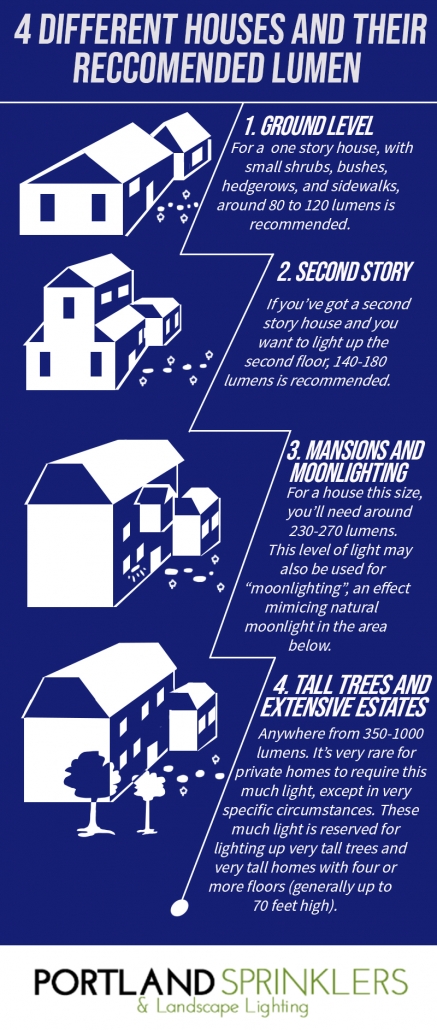L umens: A Better Measurement
umens: A Better Measurement
When you think of bulbs, you probably do so in terms of wattage. That’s how bulbs are labeled, after all. More watts means more light, right? Well, no, actually. You see, wattage is a measurement of energy use, not light output. When all we had were incandescent lights, watts worked fine as a measurement, but technology always changes the playing field. LED lights – of the sort we install with our landscape lighting – can give off the same amount of light as an incandescent bulb for as little as 20% of the wattage. So, to say how much light fixtures give off, wattage is a really bad way to judge. That’s where we get lumens.
But What Are Lumens?
The dictionary definition of a lumen is as follows: “a unit of luminous flux in the International System of Units, that is equal to the amount of light given out through a solid angle by a source of one candela intensity radiating equally in all directions.” In other words, lumens measure how much light is increased in the area the light spreads. It’s all quite a bit technical in the specifics, but all you really need to know is this: lumens measure brightness, wattage measures energy efficiency.
Getting the best value out of a light fixture is having a good ratio of wattage compared to lumens. The lower the wattage and higher the lumens, the better the light is. LEDs easily outclass all other types of lights in this category, making them the least expensive, longest lasting, and brightest lights you can get. That’s why we use them for all our fixtures. As a sample comparison, a 100 watt incandescent bulb will give off 1600 lumens. A 22 watt LED bulb will give off the same amount. Put into numbers like that, the correct choice is obvious.
How Many Lumens Do You Need?
Home Depot has a list of recommended lumens for specific types of lights. It reads as follows:
- Step lights: 12-100 lumens
- Hardscape lights (on walls): 50-185 lumens
- Landscape lights: 50-300 lumens
- Path lights: 100-200 lumens
- Landscape spotlights: 120 lumens
- Lamp posts: 120-180 lumens
- Pond/pool lights: 200-400 lumens
- Motion sensor lights: 300-700 lumens
- Flood lights: 700-1300 lumens
These are standard recommendations, however, and don’t consider particularly darker areas, or specific instances where you want more or less light. Generally speaking, the amount of lumens you want should be determined by how and what you’re trying to light up.
1. Ground Level
For a simple, one story house, with small shrubs, bushes, hedgerows, and sidewalks, around 80 to 120 lumens is usually recommended. With the right angle of beams, this lighting can give you enough light to see by and spread that light evenly around. The aim is to give cohesion: evenly spread light without any harsh glares.
2. Second Story Stuff
If you’ve got a second story house and you want to light up the second floor, 140-180 lumens is recommended. This can help light up spaces between 10 and 20 feet high. This level of lighting can also light up medium sized trees, or be used to cast striking shadows for artistic effects.
3. Mansions and Moonlighting
If you have a house with three stories, you’re going to need around 230-270 lumens to pull it off. To get this effect, you usually rely on uplights, well-lights, and spotlights. These will get you lighting on the upper stories of your house. They also provide good grazing light for the front of larger homes and mansions.
This level is also used for “moonlighting.” By placing lighting fixtures at this level at 20 to 30 feet in the air, you can create an effect that mimics natural full moonlight in the area below. It creates a great ambient lighting effect for people who want something a bit more romantic and interesting. The effect can also be achieved with level 2 lighting, but it’s usually this level of light that best achieves the effect with the least amount of planning and effort.
4. Tall Trees and Extensive Estates
Anywhere from 350-1000 lumens will fall into this category. It’s very rare for private homes to require this much light, except in very specific circumstances. These kind of light levels are reserved for lighting up very tall trees and very tall homes with four or more floors (generally up to 70 feet high). You can also use it to highlight features of tall houses, like chimneys, or other rooftop artistic displays.
Mix It Up
These four different light levels don’t act as a single fix for any situation. Generally, each level of light is used for different purposes. This means to get the best lighting effect for your home and landscape, you really want to layer the lighting. Use higher levels of lighting to achieve specific effects, while the lower level lighting gives you light to see and highlight the general features of your home. With good mixing and matching, you can create astounding, breathtaking effects for your landscape lighting.
Let Us Help!
Landscape lighting is one of our specialties! If you’re looking to get some good landscaping lighting up for your house, we know all the tricks. You can talk to us for advice on the best way to light up your landscape, or you can ask us to come out and help you set it up. We’ll help you get the best lighting set-up you can for what you want it to do. Get in touch today and see what we can do for you!

